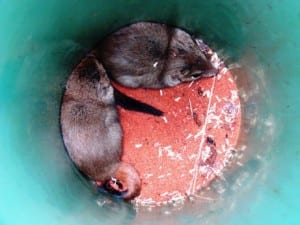How wild is that animal?
By Jack Ashby, on 14 April 2011
A delayed account of zoological fieldwork in Australia – Part 11
From April 2010 I spent about five months undertaking several zoological field projects across Australia. I worked with government agencies, universities and NGOs on conservation and ecology studies ranging from Tasmanian devil facial tumour disease, the effect of fire, rain and introduced predators on desert ecology and how to poison cats. This series of blog posts is a delayed account of my time in the field.
Weeks Twelve to Fifteen
After about three months of back-to-back field projects, I decided to take some time off and visit Tropical North Queensland with some friends for a few weeks. Unlike the majority of the field work we spent pretty much all of our time looking for wild animals without trapping them.
As I’ve mentioned in previous posts, most Australian mammals are nocturnal. There are a couple of species in North Queensland which hang out in the day (the incredible musky rat kangaroo and whales being good examples) which make life easy, otherwise you need to forgo some sleep to be rewarded.
Fortunately my friends – a former Grant Museum staffer and her husband – are both patient with my zoological nerdiness and eager to see cool stuff going about its business. Instead of getting a good night’s sleep, we spent a lot of time after dark walking round with spotlights looking for wildlife.
We were very successful. In fact, while I saw 93 mammal species in 2010, I saw more in Tropical Queensland than any other place. This is remarkable given that it was the only place where I wasn’t setting traps. Everywhere else I went nearly all the species I encountered were in traps. The obvious question is, which encounters are more valuable? Is it more rewarding to get up close or handle an animal that you’ve trapped or baited, or to see it behaving naturally at a distance (and in the dark).
Not sure I can get an answer for this. I know that I have rarely been more enthralled than when I was holding a Tasmanian devil that had been baited into a trap, with my fingers in its mouth.
When I was back in Tassie last week I eventually got to see an Australian water rat. I’ve been incredibly unlucky with this species – the most widespread mammal in Oz. I’ve spent many nights sat by creeks and even been on trapping expeditions for them, all without result. Last week, after two hours of being bitten by midges, curled up on wet ground under a tree in the dark, I finally heard the splashing plop that I have been waiting for. Flicking on my light I got to watch a wild water rat forage for about 15 minutes. I always think that experiences are all the better for being hard-earned, and this certainly was. It almost made me glad that my first encounter with this species wasn’t with an angry specimen caught in a cage trap.
I have spent a fair bit of time in India chasing tigers around. I’ve had many incredible close-up meetings with them from the back of my friend’s 4×4 jeep. He’s a wildlife photographer so in order to have 360 degree range for shots he’s sawn off all of the upright elements of the vehicle above seat level. When a wild tiger came within three feet with nothing between us it was certainly exciting, but I think my best tiger experience was from over a kilometre away.
While the jeep-based encounters are amazing something is lost in the fact that there are normally other vehicles around and the tigers always know that you can see them – they’ve chosen to allow you. On one occasion, however, we were walking through the jungle and had lunch sitting with legs dangling over a cliff-top. Below us the deer started alarm-calling and following the direction they were looking a huge male tiger strolled across the meadow on the plateau far below us. When I exclaimed that I’d found him, he turned his head and looked right at me, and even through the binoculars it was incredible. This was a chance encounter of a truly wild animal.
Back in Queensland, we stayed at a lodge catering specifically for bird-watchers. It was the kind of place where you had to pass a kind of test that you really were a nerd before they let you in. They had an orchard and some forest. I got up every two hours at night until I caught a glimpse of a striped possum at 5am, as well as incredible views of the stunning prehensile-tailed rat (the species I was here to find). Each evening they put out bird food and fruit and it attracts bandicoots, giant rats and a range of other rodents. We watched them for hours, but again their “wildness” was diminished by the fact that bait was used to bring them in.
“Pure” wild encounters are hard to come by. I’m not even sure I can define them. I think it’s got something to do with:
- working hard for the experience.
- seeing the animal behaving naturally.
- the animal being there due to reasons independent of human intervention.
- the animal not knowing you are there.
- no other people being around.
Are there any more?
Next week I’ll be back to trapping stuff. My final part of this trip was a month in Arnhem Land trapping snakes, lizards, amphibians and mammals with the Australian Wildlife Conservancy.
UPDATE: PART TWELVE HERE
One Response to “How wild is that animal?”
- 1
 Close
Close





[…] UPDATE: PART ELEVEN HERE […]